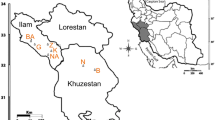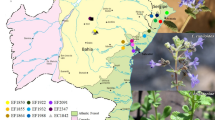Abstract
Genetic variation of 10 Rhodiola alsia (Crassulaceae) populations from the Qinghai–Tibet Plateau of China was investigated using intersimple sequence repeat (ISSR) markers. R. alsia is an endemic species of the Qinghai–Tibet Plateau. Of the 100 primers screened, 13 were highly polymorphic. Using these primers, 140 discernible DNA fragments were generated with 112 (80%) being polymorphic, indicating pronounced genetic variation at the species level. Also there were high levels of polymorphism at the population level with the percentage of polymorphic bands (PPB) ranging from 63.4 to 88.6%. Analysis of molecular variance (AMOVA) showed that the genetic variation was mainly found among populations (70.3%) and variance within populations was 29.7%. The main factors responsible for the high level of differentiation among populations are probably the isolation from other populations and clonal propagation of this species. Occasional sexual reproduction might occur in order to maintain high levels of variation within populations. Environmental conditions could also influence population genetic structure as they occur in severe habitats. The strong genetic differentiation among populations in our study indicates that the conservation of genetic variability in R. alsia requires maintenance of as many populations as possible.
Similar content being viewed by others
References
Ambruster, W. S., and Schwaegerle, M. J. (1996). Causes of co-variation of phenotypic traits among populations. J. Evol. Biol. 9:261–276.
Balloux, F., and Lugon-Moulin, B. (2002). The estimation of population differentiation with microsatellite markers. Mol. Ecol. 11:155–165.
Barth, S., Melchinger, A. E., and Lubberstedt, T. H. (2002). Genetic diversity in Arabidopsis thaliana L. Heynh. investigated by cleaved amplified polymorphic sequence (CAPS) and inter-simple sequence repeat (ISSR) markers. Mol. Ecol. 11:495–505.
Brauner, S., Crawford, D. J., and Stuessy, T. F. (1992). Ribosomal DNA and RAPD variation in the rare plant family Lactoridaceae. Am. J. Bot. 79:1436–1439.
Camacho, J. C., and Liston, A. (2001). Population structure and genetic diversity of Botrychium pumicola (Ophioglossaceae) based on inter-simple sequence repeats (ISSR). Am. J. Bot. 88:1065–1070.
Dolan, R. W. (1994). Patterns in isozyme variation in relation to population size, isolation, and phytogeographic history in royal catchfly (silene regia; Caryophyllaceae). Am. J. Bot. 81:965–972.
Donnelly, M. J., and Twonson, H. (2000). Evidence for extensive genetic differentiation among populations of the malaria vector Anopheles arabiensis eastern Africa. Insect Mol. Biol. 9:357–367.
Doyle, J. J., and Doyle, J. L. (1987). A rapid DNA isolation procedure for small quantities of fresh leaf tissue. Focus 12:13–15.
Ellstrand, N. C., and Elam, D. R. (1993). Population genetic consequences of small population size: implications for plant conservation. Annu. Rev. Ecol. Syst. 24:217–242.
Erickson, D. L., and Hamrick, J. L. (2003). Genetic and clonal diversity for Myrica cerifera along a spatiotemporal island chronosequence. Heredity 90:25–32.
Esselman, E. J., Li, J. Q., Crawford, D. J., Winduss, J. L., and Wolfe, A. D. (1999). Clonal diversity in the rare Calamagrostis porteri ssp. Insperata (Poaceae): comparative results for allozymes and random amplified polymorphic DNA (RAPD) and inter simple sequence repeat (ISSR) markers. Mol. Ecol. 8:443–451.
Excoffier, L., Smouse, P. E., and Quattro, J. M. (1992). Analysis of molecular variance inferred from metric distances among DNA haplotypes: Application to human mitochondrial DNA restriction data. Genetics 131:479–491.
Fang, D. Q., and Roose, M. L. (1997). Identification of closely related citrus cultivars with inter-simple sequence repeat markers. Theor. Appl. Genet. 95:408–417.
Fischer, M., and Matthies, D. (1998). RAPD variation in relation to population size and plant performance in the rare Gentianella germanica. Am. J. Bot. 85:811–819.
Fischer, M., Husi, R., Prati, D., Peintinger, M., Kleune, M. V., and Schmid, B. (2000) RAPD variation among and within small and large populations of the rare clonal plant Ranunculus reptans (Ranunculaceae). Am. J. Bot. 87:1128–1137.
Fu, C. X., Qiu, Y. X., and Kong, H. H. (2003). RAPD analysis for genetic diversity in Changium smyrnioides (Apiaceae), an endangered plant. Bot. Bull. Acad. Sin. 44:13–18.
Fu, K. J., and Ohba, H. (2001). Rhodiola (Crassulaceae). In Wu, Z. Y., and Raven, P. (eds.), Flora of China, Vol. 8, Science Press, Beijing, pp. 253–263.
Ge, X. J., and Sun, M. (1999). Reproductive biology and genetic diversity of a cryptoviviparous mangrove Aegiceras corniculatum (Myrtinaceae) using allozyme and inter-simple sequence repeat (ISSR) analysis. Mol. Ecol. 8:2061–2069.
Gerlach, G., and Musolf, K. F. (2000). Fragmentation of landscape as a cause for genetic subdivision in bank voles. Conserv. Biol. 14:1066–1074.
Hewitt, G. M. (1996). Some genetic consequences of ice ages, and their role in divergence and speciation. Biol. J. Linn. Soc. 58:247–276.
Huff, D. R., Peakall, R., and Smouse, P. E. (1993). RAPD variation within and among natural populations of outcrossing buffalo grass (Buchloe dactyloides (Nutt.) Engelm.). Theor. Appl. Genet. 86:927–934.
Li, A., and Ge, S. (2002). Genetic variation and clonal diversity of Psammochloa villosa (Poaceae) detected by ISSR markers. Ann. Bot. 87:585–590.
Max, K. N., Mouchaty, S. K., and Schwaegerle, K. E. (1999). Allozyme and morphological variation in two subspecies of Dryas octopetala (Rosaceae) in Alaska. Am. J. Bot. 86:1637-1644.
Miehe, G., and Sabine, M. (2000). Environmental Changes in the Pastures of Xizang. Marb. Geo. Sch. 135:282–311.
Milligan, B. G., Leebens-Mack, J., and Strand, A. E. (1994). Conservation genetics: beyond the maintenance of marker diversity. Mol. Ecol. 3:423–435.
Nagaoka, T., and Ogihara, Y. (1997). Applicability of inter-simple sequence repeat polymorphisms in wheat for use as DNA markers in comparison to RFLP and RAPD markers. Theor. Appl. Genet. 94:597–602.
Palsson, S. (2000). Microsatellite variation in Daphnia pulex from both side of the Baltic Sea. Mol. Ecol. 9:1075–1088.
Raijmann, L. E. L., Leeuwen, N. C., Kersten, R., Oostermeuer, J. G. B., Den, H. C. M., and Menken, S. B. J. (1994). Genetic variation and outcrossing rate in relation to population size in Gentiana pneumonanthe L. Conserv. Biol. 8:113–126.
Reisch, C., Poschlod, P., and Wingender, R. (2003). Genetic variation of Saxifraga paniculata Mill. (Saxifragaceae): molecular evidence for glacial relic endemism in central Europe. Biol. J. Linn. Soc. 80:11–21.
Rohlf, F. J. (1994). NTSYS-pc. Numerical Taxonomy and Multivariate Analysis System, Vol. 1.1 80, Exeter Software, New York.
Rossetto, M., Jezierski, G., Hopper, S. D., and Dixon, K. W. (1999). Conservation genetics and clonality in two critically endangered eucalypts from the highly endemic south-western Australian flora. Biol. Conserv. 88:321–331.
Schmid, B. (1984). Niche width and variation within and between population in colonizing species (Carex flava group). Oecologia 63:1–5.
Schmid, B. (1986). Patterns of variation and population structure in the Carex flava group. Sym. Bot. Upsal. 27:113–126.
Shi, Y. F., Li, J. J., and Li, B. Y. (1998). Uplift and Environmental Changes of Qinghai–Tibetan Plateau in the lAte Cenozoic, Gaungdong Science and Technology Press, Guangzhou.
Simberloff, D. (1988). The contribution of population and community biology to conservation science. Annu. Rev. Ecol. Syst. 19:473–512.
Slatkin, M. (1985). Gene flow in natural populations. Annu. Rev. Ecol. Syst. 16:393–430.
Tang, Y., Guang, Z. J., and Zu, Y. G. (2002). Seed dispersal pattern and germination test of Rhodiola sachalinensis. J. Forest. Res. 13:123–126.
Tani, N., Tomaru, N., Tsumura, Y., Araki, M., and Ohba, K. (1998). Genetic structure within a Japanese stone pine (Pinus pumila Regel) population on Mt. Aino-dake in Central Honshu, Japan. J. Plant Res. 111:7–15.
Tiedemann, R., Hardy, O., Vekemans, X., and Milinkovitch, M. C. (2000). Higher impact of female than male migration on population structure in large mammals. Mol. Ecol. 9:1159–1163.
Travis, S. E., Maschinski, J., and Kleim, P. (1996). An analysis of genetic variation in Astragalus cremnophylax var. cremnophylax, a critically endangered plant, using AFLP markers. Mol. Ecol. 5:735–745.
Tsumura, Y., Ohba, K., and Strauss, S. H. (1996). Diversity and inheritance of inter-simple sequence repeat polymorphisms in douglas-fir (Pseudotsuga menziesii) and sugi (Cryptomeria japonica). Theor. Appl. Genet. 9:40–45.
Van Treuren, R., Delden, W., and Ouborg, N. J. (1991). The significance of genetic erosion in the process of extinction. I. Genetic differentiation in Salvia pratensis and Scabiosa columbaria in relation to population size. Heredity 66:181–189.
Wang, Q., Ge, S., and Hong, D. Y. (2001). Genetic variation within and among populations of a wild rice Oryza granulate from China detected by RAPD and ISSR markers. Theor. Appl. Genet. 102:440–449.
Wolfe, A. D., and Liston, A. (1998). Contributions of PCR-based methods to plant systematics and evolutionary biology. In Soltis, D. E., Soltis, P. S., and Doyle, J. J. (eds.), Molecular Systematics of Plants. II. DNA Sequencing, Chapman and Hall, New York, pp. 43–86.
Wu, C. Y. (1987). Preface. In Wu, C. Y. (ed.), Flora of Tibet, Vol. 5, Science Press, Beijing.
Wulff, E. V. (1944). Historical Plant Geography, History of the World Flora, Moscow.
Yan, T. F., Yan, X. F., Zhou, F. J., and Zu, Y. G. (1999a). Research on the distribution and differentiation of RAPD polymorphic fragments for Rhodiola sachalinensis. In Zu, Y. G., Sun, M., and Kang, L. (eds.), The Application, Method and Theory of molecular Ecology, China Higher Education Press, Beijing, pp. 167–176.
Yan, T. F., Yan, X. F., and Zu, Y. G. (1999b). A primarily discuss on the adaptive mechanism at different altitude level of Rhodiola sachalinensis population. Bull. Bot. Res. 19:201–206.
Yeh, F. C., Yang, R. C. B., Timothy, B. J., Ye, Z. H., and Mao, J. X. (1997). POPGENE, the User-Friendly Shareware for Population Genetic Analysis, Molecular Biology and Biotechnology Centre, University of Alberta, Canada.
Young, A., Boyle, T., and Brown, T. (1996). The population genetic consequence of habitat fragmentation for plants. Trends Ecol. Evol. 11:413–418.
Zietkiewicz, E., Rafalski, A., and Labuda, D. (1994). Genome fingerprinting by simple sequence repeat (SSR)-anchored polymerase chain reaction amplification. Genomics 20:176–183.
Zu, Y. G., Yan, T. F., and Zhou, F. J. (1998). A preliminary study on genetic variation and endangered mechanism of natural population. Bull. Bot. Res. 18:304–310.
Author information
Authors and Affiliations
Corresponding author
Rights and permissions
About this article
Cite this article
Xia, T., Chen, S., Chen, S. et al. Genetic Variation Within and Among Populations of Rhodiola alsia (Crassulaceae) Native to the Tibetan Plateau as Detected by ISSR Markers. Biochem Genet 43, 87–101 (2005). https://doi.org/10.1007/s10528-005-1502-5
Received:
Accepted:
Issue Date:
DOI: https://doi.org/10.1007/s10528-005-1502-5




